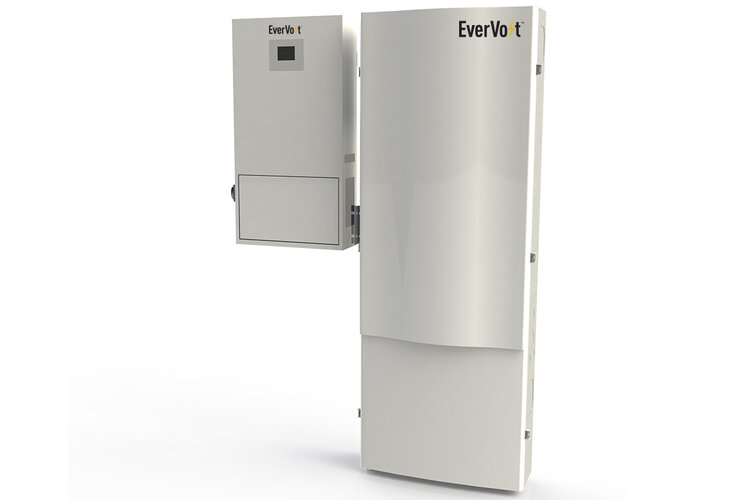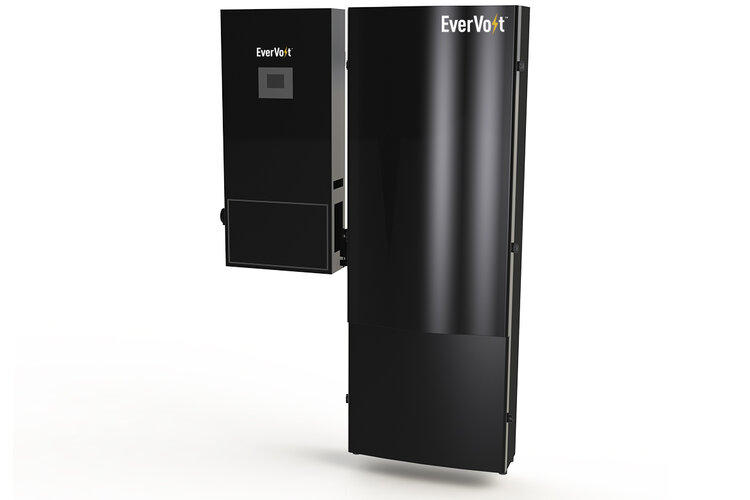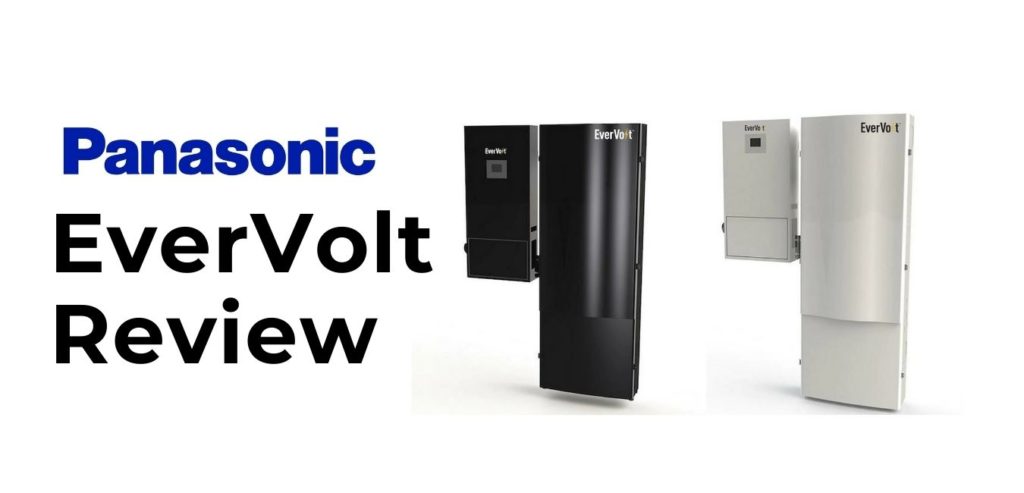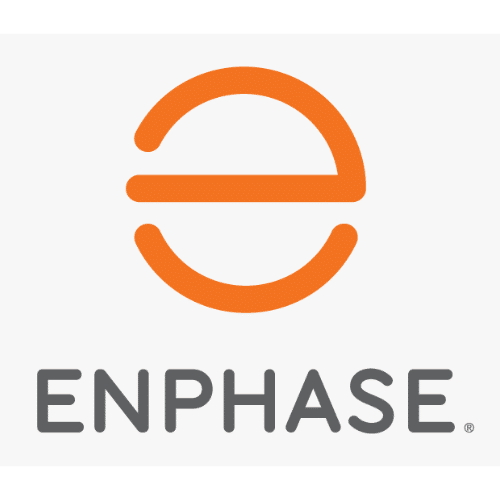Reviewing Panasonic's EverVolt Battery
Panasonic has been a leader in the solar energy industry for many years, and it stands to reason that their expertise includes not only solar panels but also battery technologies as well, with their 2019 launch of the EverVolt battery backup system.
In this article, we’ll take an in-depth look at Panasonic’s EverVolt system, including how it works, where it can be implemented, how much it costs, and more.
How Does The Panasonic EverVolt Work?
The EverVolt home battery storage system stores electricity that you can then access during peak energy-usage hours, low energy-production hours, and grid outages. This gives you essentially a private energy storage bank that you can dip into whenever it’s necessary that keeps your energy supply consistent, steady, and reliable.
Using a solar power system with a battery backup also allows you as a homeowner to lower your carbon footprint, be more independent from the grid, and save money on energy costs.
A Sophisticated Home Battery Backup System
The EverVolt is even more sophisticated than just providing backup power – it allows you to program your system to supply energy from the battery at times when grid energy is at its peak rates, which saves you money. Additionally, if you expect or know an outage is coming, you can set your system to priority backup mode, which rapidly charges your battery bank with grid power so that you can have as much backup power as possible.
And, if your local utility company allows it, you can even buy cheap energy from the grid during non-peak times, store it in your home battery bank, use it during expensive peak times, and sell surplus energy from your solar energy system back to the grid when the rates are the most favorable so you get the biggest energy bill credits possible.
A Sophisticated Home Battery Backup System
Finally, you don’t even need a solar energy system in place to install an EverVolt battery backup system. You can simply install it in your grid-powered home and charge it up as needed to take advantage of lower-priced non-peak energy or back up your home in the case of a grid outage.


How Does EverVolt Perform?
There are two main ways to judge the performance of a battery: its roundtrip efficiency and its depth of discharge.
Roundtrip Efficiency
Roundtrip efficiency refers to the percentage of energy that is retained through a cycle of charging and discharging the battery. The EverVolt AC-coupled batteries have a roundtrip efficiency of 89% and the DC-coupled version is rated at 90%. This means that if you charge your batteries with 10 kWh of electricity, you will get 8.9 kWh of power output for your AC appliances and 9 kWh for your DC appliances.
Depth Of Discharge
Depth of discharge refers to the percentage of energy discharged from the battery compared to the overall capacity of the battery. Since all batteries suffer diminishing capacity over time, this is a useful metric to determine how long or for how many charge and recharge cycles you can expect your battery to produce a useful amount of power.
Unfortunately, Panasonic does not have a depth of discharge rating on its Evervolt spec sheets, but the warranty indicates that you can expect at least 60% of the battery’s initial capacity to remain usable after 10 years.
AC-Coupled vs. DC-Couples EverVolt Batteries
Panasonic designed their EverVolt system to be able to work with both AC and DC systems so you have flexible installation options. This allows you to add an EverVolt battery bank into essentially any existing solar energy system, not just new systems that are specifically planned with the EverVolt in mind.
The EverVolt is available in different storage size options ranging from 11-102 kWh, so you can customize your storage for your specific needs. The AC and DC versions are both available in Standard and Plus variations, with different capacity ratings for each. This modular design provides maximum efficiency and the most power possible. Some homeowners may only wish to partially back up their home while others may want backup power for their entire home.
Experience Long Grid Outages? Read This.
If you regularly experience long grid outages, a bigger system will be more beneficial in that it can store enough energy to tide you over until the grid power is restored. This in itself can save you tons of money, because if you have a fridge and freezer full of groceries and the power goes out for several days, you can lose hundreds of dollars in spoiled food.
The EverVolt battery system can also be integrated with a generator so that you can enjoy electricity even during a grid outage without having to run the generator constantly.
EverVolt AC-Coupled
The AC-coupled EverVolt is available with either four or six batteries and works with or without solar energy. It provides a flexible energy storage option with a capacity range of 11.4 to 17.1 kWh.
The AC system means that you do not need an inverter between your battery bank and your appliances since the power is already AC, which is what the vast majority of home appliances use. It also means you can seamlessly integrate a generator or just charge the battery backup system from the grid for later use.
EverVolt DC-Coupled
The DC-coupled EverVolt offers more comprehensive storage options, with the same four and six battery options and capacity ranging from 11.4 kwh to 102 kWh. You can also stack up to three DC EverVolt units for complete home power backup. It can be used with solar energy, a generator, or simply power from the grid. However, the most common use for the DC EverVolt units is with a home solar energy system.
Can The EverVolt Work With Existing Solar Panel Systems?
As we mentioned up above, it certainly can. As we mentioned, the EverVolt is available in both AC and DC versions, so no matter how your system is set up and where you plan to place the unit in your grid, it can be seamlessly added. It also comes in such a wide range of capacities that you can easily configure an EverVolt to store all the energy you need to effectively back up your home.
The system is compatible with all kinds of solar panels and inverters, so you do not need to use all Panasonic products. However, it is designed intentionally to be used with Panasonic HIT solar panels for maximum efficiency and power production.
EverVolt App Review
Panasonic provides a companion app with its solar energy products so you can view real-time energy usage and watch your panels generate power, if applicable. You can also manage your system’s operation, charge and discharge levels, net metering, and more via the app.
Can I Control My Energy Supply Using the App?
You certainly can, both via the app and with the on-unit screen. This screen is a great backup feature in case your power supply is off, which of course would turn off the wireless internet and make the app unusable unless you have cell service and data coverage.
Panasonic EverVolt Cost
You can expect that the total cost of installing an EverVolt backup system will range between $15,000 and $20,000. The exact cost depends on which battery system you select as well as the overall size and capacity of your system.
This estimate also includes a generalized installation cost, but the price of installation can vary dramatically based on your existing system, whether you are starting from scratch and even your location.
If you are looking to install an entire solar energy system with battery backup, you can expect to spend another $9,000 to $15,000 on solar energy equipment like panels, inverters, mounting systems, permits, and so forth.
Possible Solar Incentives
However, keep in mind that there are many federal, state, and local solar incentives available for installing solar energy systems. These are often in the forms of rebates, tax credits, and net metering, all of which can significantly offset both the initial cost of installation and provide you with lasting ‘income’ which can be used against your monthly power bill. So, you may pay significantly less than that amount once solar incentives have been applied.
At Sunbridge, we service Oregon and Washington State. To learn more about solar incentives in these areas, please see below for further readings. To learn more about incentives in your states, contact a local solar company in your area.
Panasonic EverVolt Warranty
The EverVolt is covered by Panasonic’s 10-year complete system warranty. This warranty guarantees that the battery will have 60% or more of its original capacity after the 10-year warranty period or whenever the total energy throughput exceeds 7.56 MWh per battery module, whichever comes first. The warranty also covers faulty parts, defects, and the performance of the battery.
Why Choose EverVolt? Our Final Opinion
The Panasonic EverVolt system is conveniently designed to be modular, it has AC and DC versions as well as different capacity options, it is easy to control and monitor both via the app and on the built-in screen, and it’s reasonably priced when compared to similar products. It also has a solid warranty and can effectively be used in many different home energy situations.
Our final opinion is that the EverVolt system is an excellent choice that allows you to maximize your solar energy investment while minimizing your monthly energy bill, reduce your carbon footprint, and give you grid independence.







